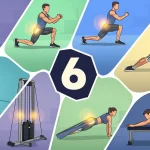Muay Thai, also known as the Art of Eight Limbs, is one of the most dynamic martial arts in the world.
For beginners, mastering the basic techniques is key to building a solid foundation before moving on to more advanced movements.
Curious about what techniques you need to learn? Let’s explore the 7 essential Muay Thai techniques that every beginner should master!
1. Stance (Proper Starting Position)
The stance is the fundamental building block of Muay Thai. A proper stance helps maintain balance and allows for quick transitions between offense and defense.
How to Perform:
- Stand with one foot slightly in front of the other.
- Bend your knees slightly for flexibility.
- Keep your hands up to protect your face, with elbows close to your body.
Tips:
- Keep your chin slightly tucked to protect your jaw.
- Distribute your weight evenly across both feet for smoother movement.
2. Punches
Punching is one of the most commonly used techniques in Muay Thai. It requires coordination between your hands, shoulders, and hips to generate power.
Basic Punches:
- Jab: A quick punch with the lead hand to measure distance.
- Cross: A powerful straight punch with the rear hand.
- Hook: A circular punch targeting the side of the opponent’s head or body.
- Uppercut: An upward punch aimed at the opponent’s chin.
Tips:
- Rotate your hips while punching to maximize power.
- Always return your hand to a guarding position after each punch.
3. Kicks
Kicks are a defining element of Muay Thai, using the legs and hips to deliver powerful strikes.
Basic Kicks:
- Roundhouse Kick: A circular kick aimed at the thighs, body, or head.
- Push Kick (Teep): A front kick used to maintain distance or disrupt the opponent’s balance.
Tips:
- Lift your knee high before extending your leg for maximum power.
- Strike with the shin rather than the foot for a stronger impact.
4. Knees
Knees are one of the most devastating weapons in Muay Thai, ideal for close-range combat.
Basic Knee Strikes:
- Straight Knee: A direct knee strike aimed at the opponent’s stomach or chest.
- Jumping Knee: A knee strike performed with a jump, targeting the opponent’s head or upper body.
Tips:
- Grab the opponent’s head or torso to improve accuracy and control.
- Use your hips to drive the knee forward for added power.
5. Elbows
Elbows are highly effective in close-range combat, known for their sharpness and precision.
Basic Elbow Strikes:
- Horizontal Elbow: A horizontal strike aimed at the opponent’s head.
- Upward Elbow: A strike directed upward, targeting the chin.
- Spinning Elbow: A spinning strike used as a surprise attack.
Tips:
- Keep your elbows close to your body before striking to maintain power.
- Aim for unprotected areas of the opponent’s body.
6. Clinch
The clinch is a grappling technique used to control your opponent at close range, often leading to knee strikes or sweeps.
How to Perform:
- Hook your hands behind the opponent’s neck.
- Use your upper body strength to pull the opponent toward your knees.
Tips:
- Keep your body upright to maintain balance.
- Avoid giving too much space for the opponent to counter.
7. Defense
Defense is as crucial as offense in Muay Thai. It involves blocking, evading, and redirecting strikes to minimize damage.
Basic Defensive Techniques:
- Block: Use your hands or legs to shield against strikes.
- Parry: Redirect punches away from your body.
- Dodge: Move your head or body to avoid attacks.
Tips:
- Stay calm and focused to read your opponent’s movements.
- Practice reaction drills to improve reflexes.
Conclusion: The Key to Success Lies in the Basics
Mastering the basics of Muay Thai is the first step toward achieving greater skill levels.
By focusing on foundational techniques such as punches, kicks, elbows, and knees, you’ll develop strength, speed, and precision in your movements.
#StayFocus and begin your Muay Thai journey by mastering these essential techniques!





